-
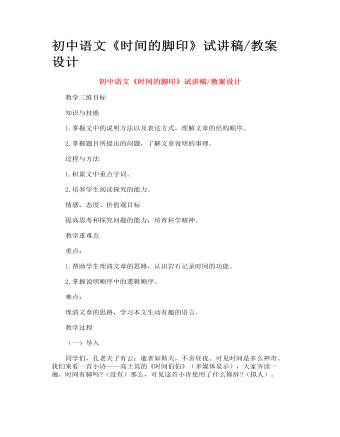
初中语文《时间的脚印》试讲稿_教案设计
同学们,孔老夫子有云:逝者如斯夫,不舍昼夜。可见时间是多么神奇。我们来看一首小诗——高士其的《时间伯伯》(多媒体显示),大家齐读一遍。时间有脚吗?(没有)那么,可见这首小诗使用了什么修辞?(拟人)。 我们今天学习的课文文题就源于高士其这首小诗。(板书课题:8.时间的脚印)这课题也采用什么修辞?(拟人)这是一篇科普作品,了解一下它的作者( 看图了解陶世龙)。先来欣赏图片,第一张自然界中的沉积岩、第二张“恐龙化石”、第三张“三叶虫化石”。(屏幕显示)。我们看到的这些岩石,在保存古代生物的同时,还记下了时间的痕迹。那么,岩石是怎样记录时间的呢?带着这个问题,我们一起来学习《时间的脚印》。我们来看看这节课的学习目标。
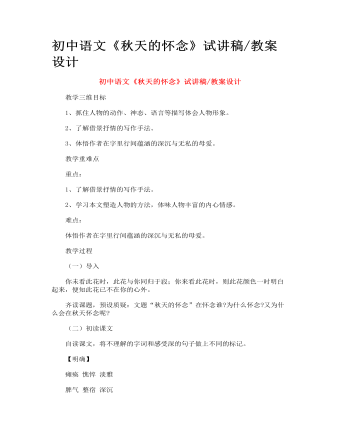
初中语文《秋天的怀念》试讲稿_教案设计
深层探究 在那个树叶“刷刷拉拉”飘落的季节里,母亲离我远去了。我怀念我的母亲,怀念她为我付出的艰辛,为我承受的苦痛和她给予我的爱。除此,母亲还给了我更为宝贵的东西,那是什么? 【明确】:是母亲交给我的生活态度,价值观,她让我有了直面苦难的勇气、信心和力量。 这世间有很多东西,当我们懂得珍惜,回头却发现他已经不在了。比如说光阴、健康、生命、亲情、友情…… 史铁生和母亲的故事,史铁生“好好活”的人生一定让你有所触动,有些问题你可能没有想过,有些话你也没有说过,因为你还拥有着。 (让学生充分展示,说出自己的心里话。) 小结:这是一位病入膏肓的母亲,一位苦难坚忍的母亲;这是一位强大智慧的母亲,一位大爱无声的母亲!这个母亲养育了我,陪伴了我,成就了我。 天底下每一位母亲都同样伟大。她们为儿女同样倾我所有,操尽心机;她们同样青丝白发,毫无保留。
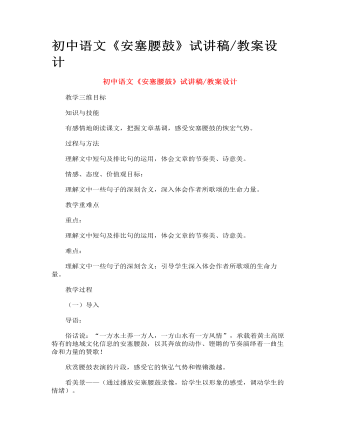
初中语文《安塞腰鼓》试讲稿_教案设计
精读课本,贯通全文 提问:整篇文章极富震撼力,文章中一个排比接一个排比,一个高潮连一个高潮,大家从中体味到了什么? 明确: A、这是一篇歌颂激荡的生命和磅礴的力量的文章。 B、全文洋溢着一种阳刚之美。 C、表现要冲破束缚、阻碍的强烈渴望。 朗读赏析探究 赏美图,配佳句——为了让大家对被誉为“天下第一鼓”的安塞腰鼓有更直观的认识,我们再来看几组特写照片。看后请各小组用课文中的文句与之相配并高声朗读。 明确:对排比句进行总结,说出对句子的理解。 怎样理解“耳畔是一声渺远的鸡声”? ①鸡啼预示天明,是新的一天的开始,是希望的象征。 ②这是以声衬静,用鸡啼反衬火烈的鼓声停止后大地的寂静。 说美点,品美韵——这篇文章美吗?美在哪里? 语言美: 课文多用短句来表现内容;大量运用排比,有句内、句与句、段与段之间的排比,交错出现,连用许多。
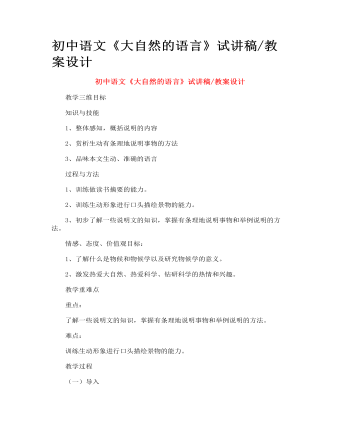
初中语文《大自然的语言》试讲稿_教案设计
竺可桢(1890--1974),浙江上虞人。气象学家、地理学家、教育家。中国近代地理学和气象学的奠基者。领导创建了我国第一个气象研究所和首批气象台站,并在台风、季风、气候变迁、农业气候、物候、自然区划等方面有开拓性的研究。创建了我国第一个地学系,成为当时培养地学英才的摇篮。以求实精神领导浙江大学工作,培育了多方面的人才。长期领导中国科学院工作,积极倡导并组织和参加中国地学、生物学、天文学、自然资源综合考察及自然科学史研究等多方面工作,主编了《中国自然区划》、《中国自然地理》等丛书,是我国地理学和气象学界的一代宗师。
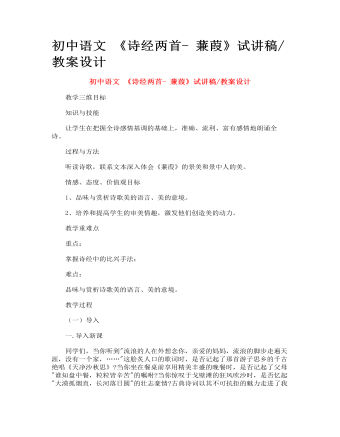
初中语文 《诗经两首- 蒹葭》试讲稿_教案设计
同学们,当你听到"流浪的人在外想念你,亲爱的妈妈,流浪的脚步走遍天涯,没有一个家,……"这脍炙人口的歌词时,是否记起了那首游子思乡的千古绝唱《天净沙秋思》?当你坐在餐桌前享用精美丰盛的晚餐时,是否记起了父母"谁知盘中餐,粒粒皆辛苦"的嘱咐?当你惊叹于戈壁滩的狂风吹沙时,是否忆起"大漠孤烟直,长河落日圆"的壮志豪情?古典诗词以其不可抗拒的魅力走进了我们的生活,为我们的生活增添了更多的美丽与奇妙。今天,让我们一起学习《蒹葭》这首诗歌,再一次用诗歌滋润我们渴求的心灵。
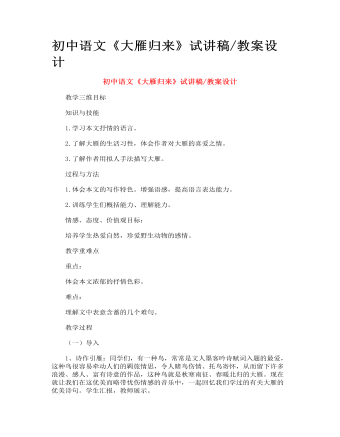
初中语文《大雁归来》试讲稿_教案设计
1、诗作引雁:同学们,有一种鸟,常常是文人墨客吟诗赋词入题的最爱,这种鸟很容易牵动人们的羁旅情思,令人睹鸟伤情、托鸟寄怀,从而留下许多浪漫、感人、富有诗意的作品,这种鸟就是秋寒南征、春暖北归的大雁。现在就让我们在这优美而略带忧伤情感的音乐中,一起回忆我们学过的有关大雁的优美诗句。学生汇报,教师展示。 征蓬出汉塞,归雁入胡天。——王维《使至塞上》 长风万里送秋雁,对此可以酣高楼。——李白《宣州谢眺楼饯别校书叔云》 乡书何处达?归雁洛阳边。——王湾《次北固山下》(思乡情怀) 塞下秋来风景异,衡阳雁去无留意。——范仲淹《渔家傲》 云中谁寄锦书来,雁字回时,月满西楼。—— 李清照《一剪梅》 2、引入课题:由此可见,中国人眼中的大雁是这样的富有诗情画意,是这样的充满浪漫色彩。那你想不想知道,外国人心中的大雁是怎样的吗?今天,就让我们跟随美国生态学家利奥波德一同走进大雁的世界。请大家打开课本111页,第十四课,大雁归来(出示课题和作者)
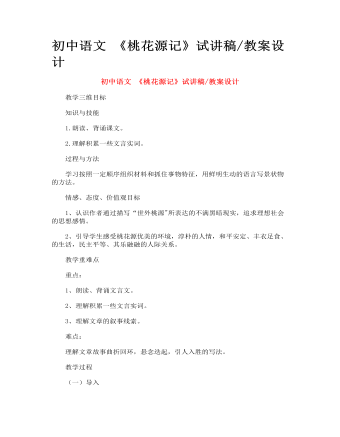
初中语文 《桃花源记》试讲稿_教案设计
陶渊明生于东晋末朝,出身于没落的地主官僚家庭。他少时颇有壮志,博学能文,任性不羁。当时社会动乱不安,他有志不得展。做过小官,由于不满官场的丑恶,弃官回乡,这时他四十一岁,从此过着“躬耕自资”的隐居生活。忧愤、饥寒、劳累、赢疾一起折磨着他,六十三岁去世。后称靖节先生。他所作的诗文,内容多描写农村生活,表现了优美的自然风光,抒发他热爱田园生活、乐于和农民来往和不愿与统治者同流合污的高尚感情;但也包含了乐天知命、消极适世的因素。在形式上一反当时华而不实的文风,明朗清新,质朴自然,善于抓住客观事物最突出的特征,淡淡几笔传神的表现它的形象,简洁含蓄而富有韵味,对后代作家有较大的影响。本文写作年代大约是宋永初二年(421年),其时陶渊明已经五十七岁了。他拒绝同刘格的来政权合作,不满黑暗的政治现实,同时由于他和农民接近,理解他们追求理想社会的愿望,所以写了这篇记和诗。
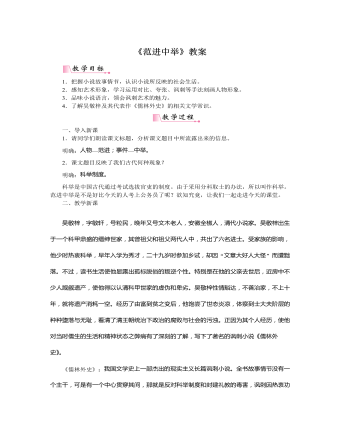
部编版语文九年级上册《范进中举》教案
目标导学一:了解作者,了解作品吴敬梓,字敏轩,号粒民,晚年又号文木老人,安徽全椒人,清代小说家。吴敬梓出生于一个科甲鼎盛的缙绅世家,其曾祖父和祖父两代人中,共出了六名进士。受家族的影响,他少时热衷科举,早年入学为秀才,二十九岁时参加乡试,却因“文章大好人大怪”而遭黜落。不过,读书生活使他显露出孤标脱俗的叛逆个性。特别是在他的父亲去世后,近房中不少人觊觎遗产,使他得以认清科甲世家的虚伪和卑劣。吴敬梓性情豁达,不善治家,不上十年,就将遗产消耗一空。经历了由富到贫之变后,他饱尝了世态炎凉,体察到士大夫阶层的种种堕落与无耻,看清了清王朝统治下政治的腐败与社会的污浊。正因为其个人经历,使他对当时儒生的生活和精神状态之弊病有了深刻的了解,写下了著名的讽刺小说《儒林外史》。
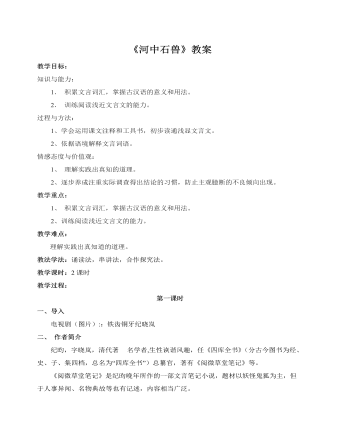
部编版语文七年级下册《河中石兽》教案
一、导入电视剧(图片)::铁齿铜牙纪晓岚 二、 作者简介纪昀,字晓岚,清代著 名学者,生性诙谐风趣,任《四库全书》(分古今图书为经、史、子、集四档,总名为“四库全书”)总纂官,著有《阅微草堂笔记》等。《阅微草堂笔记》是纪昀晚年所作的一部文言笔记小说,题材以妖怪鬼狐为主,但于人事异闻、名物典故等也有记述,内容相当广泛。三、感知课文 这篇课文讲了一个故事:有一个庙靠近河,庙门倒塌之后,门旁的两只石狮也掉到了河里。后来要修庙,决定要把石狮打捞上来。有人说,到下游去找,因为石狮被水冲走了,结果在下游没找到。一个读书人说,石狮肯定沉到沙泥里去了,因为石头重,沙泥轻,结果在庙前的沙泥里也没找到。一个老水手最后说,这两个石狮在上游,结果果然在上游打捞到了。 怎么会到上游去呢?阅读完课文后我们便知道了。反复朗读,读准字音
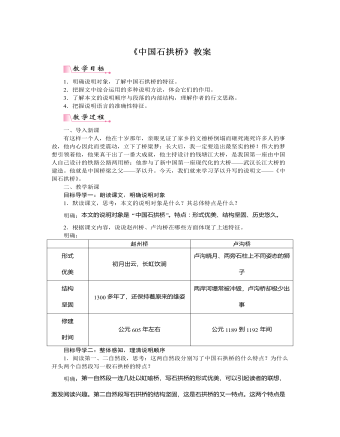
部编版语文八年级上册《中国石拱桥》教案
目标导学四:揣摩语言,把握说明效果为了准确地说明事物,说明文很讲究用语的分寸。请品味下面的语句,回答括号内的问题。1.石拱桥在世界桥梁史上出现得比较早。(“比较”一词去掉行吗?)明确:不行,“比较”程度较轻,是与其他桥梁比较而言,这样表达比较准确。2.这种桥不但形式优美,而且结构坚固。(“不但”“而且”能否删去?“结构坚固”“形式优美”能否调换顺序?)明确:“不但”“而且”不能删去,如果删去,它们之间的关系就变成了并列关系。先说外观,再说功能,符合人们的认识逻辑。并且对于桥来说,其实用价值远远重于形式,所以二者不能调换顺序。3.《水经注》里提到的“旅人桥”,大约建成于公元282年,可能是有记载的最早的石拱桥了。(“大约”“可能”“有记载的”有什么表达效果?)明确:“大约”“可能”都表示不确定,只是推测的情况。“有记载的”使话语的根据更具可靠性。

人教版高中历史必修3文艺复兴和宗教改革教案
三、宗教改革:1、背景:(1)文艺复兴的影响。文艺复兴中,人文主义学者尽管对宗教保持较为温和的态度,但其以人为中心的思想极大地冲击了天主教的精神独裁,天主教的权威日益受到人们的怀疑。(2)天主教会对欧洲尤其是德意志的压榨。中世纪的天主教会对人民进行严密的精神统治,基督教信仰的核心是“原罪”和“灵魂救赎”,即人生下来就有罪,只有信仰上帝,跟随耶稣才能得救。就“灵魂救赎”而言,最初强调的是个人信仰的作用,后来,神学家们又加上了种种繁杂的宗教礼仪,而且必须得到神职人员的帮助,灵魂才能得救。在经济上,天主教会还是最大的封建主,占有大量的土地,并征收什一税,对各国人民大肆搜刮。罗马教廷每年从德意志搜刮的财富达30万古尔登(货币单位),相当于“神圣罗马帝国”皇帝每年税收额的20倍。德意志也成了被教会榨取最严重的地区,素有“教皇的乳牛”之称。
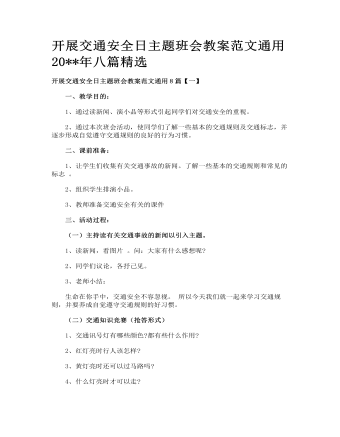
开展交通安全日主题班会教案范文通用八篇精选
骑自行车的交通安全 我国是自行车大国,许多年满12周岁的同学都骑自行车上学,骑自行车应注意哪些问题呢?下面请听一名同学朗诵《安全骑车歌》。 安全骑车歌 同学们骑自行车,听我唱段安全歌。 车铃好使闸要灵,有了情况车能停。 上街注意看信号,千万不要冒险行。 信号就是指挥员,骑车第一讲安全。 看见红灯快刹闸,该等多久等多久。 绿灯亮了才能行,安全通行不争抢。 十字路口人车多,左右观察听八方。 骑车带人危险大,攀扶车辆更可怕。 中速骑车靠右侧,分道行驶路畅通。 骑车拐弯要示意,不能猛拐一溜风。 手拉手儿把肩摸,十有八、九要撞车。 双手离把更不行,撞上汽车命归西。 骑车不走一条线,东摇西摆像醉汉。 不定哪天出事故,头破血流住医院。 驮载东西别超宽,超高超长也危险。 骑车让让讲安全,事情虽小不平凡。
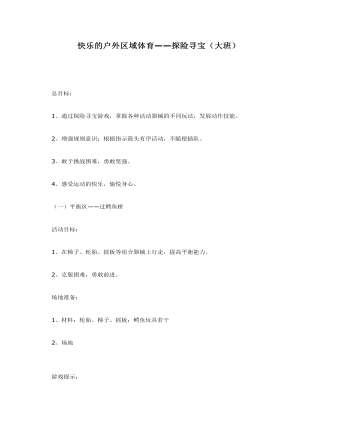
大班体育教案:快乐的户外区域体育——探险寻宝
2、增强规则意识:根据指示箭头有序活动,不随便插队。3、敢于挑战困难,勇敢坚强。4、感受运动的快乐,愉悦身心。(一)平衡区——过鳄鱼桥活动目标:1、在梯子、轮胎、摇板等组合器械上行走,提高平衡能力。2、克服困难,勇敢前进。

大班健康活动——《尖利的物品》课后反思课件教案
2、学习使用剪刀、筷子、笔、刀、游戏棒等物品的正确方法。 这节课我共分四方面来进行教学,首先让幼儿观察了解尖利物品,知道名称,了解它的用途。因为幼儿的人数较多,怕在分组活动中出现意外,所以我只准备了一份的物品让幼儿进行观察,课堂的秩序较好。在出示物品时,幼儿都能积极的举手告诉我这些物品的名称,从这里可以看出幼儿对于这些东西是十分的熟悉的;并对它们的用途也是比较了解的,大多数的幼儿一次就把所有物品的用途都说出来了,但是对于他们的共同之处幼儿的回答就不太完整,虽然知道但是不能用一个较好的词语来进行概括,从这里我发现我班幼儿在语言发展方面,词汇还是不够丰富需要加强。幼儿对‘为什么要把尖利物品设计成这样’,不太了解,有的幼儿说 “本来就是这样的”有的说“因为这样好用”……因此,在我讲了以后幼儿就有了一种恍然大捂的神情,感到很高兴,还不时和边上的同伴那进行交流。课堂的气氛一下字就活跃了起来。
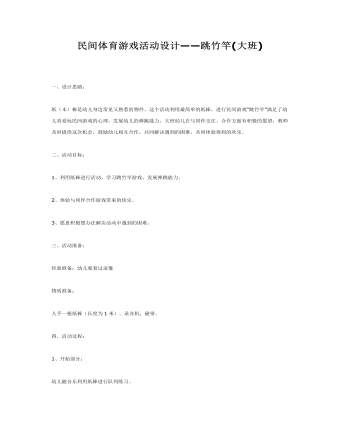
大班体育教案:民间体育游戏活动设计—跳竹竿
二、活动目标:1、利用纸棒进行活动,学习跳竹竿游戏,发展弹跳能力。2、体验与同伴合作游戏带来的快乐。3、愿意积极想办法解决活动中遇到的困难。三、活动准备:经验准备:幼儿观看过录像物质准备:人手一根纸棒(长度为1米)。录音机,磁带。四、活动过程:1、开始部分:幼儿随音乐利用纸棒进行队列练习。导语:今天天气真不错,我们骑着马出去玩玩吧!(幼儿随音乐的变化“骑马”变双圆----大圆----小圆---- “坐马车” )反思:活动开始部分设计了随音乐利用纸棒进行队列练习在这一环节中由两队“骑马”变双圆----变小圆----合作组合“坐马车”体现了动静交替的原则,让幼儿初步尝试了与同伴合作的快乐,同时也为下一个环节奠定了基础。2、基本部分:(1)利用纸棒进行“一棒多玩”导语:纸棒可以和我们玩坐马车的游戏,还可以和我们玩什么游戏呢?我们一起来试试,可以自己玩,也可以和小伙伴一起玩。(幼儿四散游戏)队形:两路纵队(见附图)(2)学习“跳竹竿”游戏A、讲解游戏玩法导语:刚才小朋友用纸棒玩了许多游戏,今天老师要和大家用纸棒玩一个新游戏——跳竹竿,这个游戏可以三个或四个小朋友一起玩,其中两个小朋友手拿竹竿面对面跪下,用竹竿同时分合敲击,另一个小朋友在中间看准竹竿的分合跳进或跳出。大家可以自己选择小伙伴一起试一试。队形:梯形队(见附图)(3)幼儿自由组合尝试玩“跳竹竿”游戏队形:四散(4)对幼儿在游戏过程中出现的情况及时进行指导(合作、交往方面)导语:你刚才和谁一起玩的?你们是怎么跳竹竿的?队形:梯形队(见附图)(5)鼓励幼儿创造性地玩“跳竹竿”游戏,师生共同参与。

新人教版高中英语必修3Unit 1 Festivals and celebrations-Discovering Useful Structure教学设计
4.That was an experience that frightened everyone. →That was _____________________. 答案:1. taking 2. being discussed 3. in the reading room 4. a frightening experienceStep 6 The meaning and function of V-ing as the predicative动词-ing形式作表语,它通常位于系动词后面,用以说明主语“是什么”或“怎么样”一种表示主语的特质、特征和状态, 其作用相当于形容词; 另一种具体说明主语的内容, 即主语等同于表语, 两者可互换。The music they are playing sounds so exciting. 他们演奏的音乐听起来令人激动。The result is disappointing. 结果令人失望。Our job is playing all kinds of music. 我们的工作就是演奏各种音乐。Seeing is believing. 眼见为实。Step 7 Practice1. It is ________(amaze) that the boy is able to solve the problem so quickly.2. Buying a car is simply _______(waste) money. 3. Please stop making the noise—it’s getting ________(annoy). 4. complete the passage with the appropriate -ing form.La Tomatina is a festival that takes place in the Spanish town Bunol every August. I think many food festivals are __________ because people are just eating. however, this festival is _________ because people don't actually eat the tomatoes. Instead, they throw them at each other! the number of people ________ part in this tomato fight, can reach up to 20,000, and it is a very __________ fight that lasts for a whole hour. The _______ thing is how clean Bunol is after the tomatoes are washed away after the fight. this is because the juice form tomatoes is really good for making surfaces clean!答案:1. amazing 2. wasting 3. annoying4. boring interesting taking exciting amazing

新人教版高中英语必修3Unit 1 Festivals and Celebrations-Reading and Thinking教学设计
The topic of this part is “Discover the reasons for festivals and celebrations.The Listening & Speaking & Talking part aims at talking about the experiences and feelings or emotions about the festivals and celebrations. This section aims at detecting the reason why the people celebrate the festivals, the time, the places, the types and the way of celebrations. It also explains why some traditions in the old celebrations are disappearing, like the firecrackers in the big cities and some new things are appearing like the prosperity of business or commerce. 1. Students can talk about what festivals they know and the reasons and the way of celebrating them.2. Students should learn the reading skills such as the headline and get the topic sentences, the structures of articles.3. Students can understand the past, the present situation of some festival around the world and why there are some changes about them. 4. Students can have the international awareness about the festivals.1. Students should learn the reading skills such as the headline and get the topic sentences, the structures of articles.2. Students can understand the past, the present situation of some festival around the world and why there are some changes about them.Step 1 Lead in---Small talkWhat festival do you like best ? Why ?I like the Spring Festivals because I can set off the fireworks, receive the lucky money and enjoy the Gala with my families.Step 2 Before reading---Pair workWhy do people celebrate different festivals ?The Spring Festivals is to celebrate the end of winter and the coming of spring and new life.The Mid-autumn Day is to celebrate the harvest and admire the moon.

新人教版高中英语必修3Unit 1 Festivals and Celebrations-Listening &Speaking&Talking教学设计
The theme of this section is “Talk about festival activities and festival experiences”.Festival and holiday is a relaxing and interesting topic for students. This part talks about the topic from the daily life of students’. In the part A ---Listening and Speaking, there are three conversations among different speakers from three countries(Japan, Rio and China), where the speakers are participating in or going to participate in the festivals and celebrations. So listening for the relationship among them is a fundamental task. Actually, with the globalization and more international communication, it is normal for Chinese or foreigners to witness different festivals and celebrations in or out of China. In the Conversation 1, a foreign reporter is interviewing a Japanese young girl who just had participated in the ceremony of the Coming-of-Age Day on the street and asking her feeling about the ceremony and the afterwards activities. Conversation 2, Chinese girl Li Mei is witnessing the Rio Carnival for the first time, and her friend Carla gives her some advice on the costumes which enables her to match with the carnival to have a good time. Conversation 3, a Chinese guide is showing a group of foreign visitors around the Lantern Festival and introducing the customs of the festival to them. The three conversations have a strong vitality and insert the festival and cultural elements from different countries. So perceiving the festivals and cultures from different countries is the second task. At the same time, the scripts also insert the targeted grammar --- v-ing as attributive and predicative, which students can perceive and experience in a real context and make a road for the further study. That is the third task. In the Part B--- Listening and Talking, the theme is “Talk about festival experience”, which is the common topic in our daily conversations. During the conversation, Song Lin, a Chinese student, asked Canadian friend Max about how to spend Christmas. In the conversation, Song Lin talked about experience and the feelings during the Chinese Spring Festival, during which there are not only some enjoyable things but some unpleasant things. After the listening, perhaps students find there are some similarities between Christmas and the Chinese Spring Festival as there are some differences in the origins and celebrations. For example, people always visit friends and relatives, decorate their houses, have a big dinner together, chat and give presents to each other.

新人教版高中英语必修3Unit 1 Festivals and Celebrations-Reading for writing教学设计二
Step 3 Analyzing article structureActivity 31. Teachers raise questions to guide students to analyze the chapter structure of this diary and think about how to describe the festival experience. (1)What should be included in the opening/body/closing paragraph(s)?(2)How did the writer arrange his/her ideas?(3)What kind of interesting details did the writer describe?(4)How did the writer describe his/her feelings/emotions during the event?2. Students read and compare the three sentence patterns in activity 2. Try to rewrite the first paragraph of the diary with these three sentence patterns. After that, students exchange corrections with their partners. Such as:●This was my first time spending three days experiencing the Naadam Festival in China’s Inner Mongolia Autonomous Region and it was an enjoyable and exciting experience. ●I'll never forget my experience at the Naadam Festival because it was my first time to watch the exciting Mongolian games of horse racing, wrestling, and archery so closely. ●I'll always remember my first experience at the Naadam Festival in China’s Inner Mongolia Autonomous Region because it was so amazing to spend three days witnessing a grand Mongolian ceremony. Step 4 Accumulation of statementsActivity 41. Ask the students to read the diary again. Look for sentences that express feelings and emotions, especially those with the -ing form and the past participle. Such as:● …horse racing, wrestling, and archery, which are all so exciting to watch. ● some amazing performances● I was surprised to see…● I was a little worried about. . . ● feeling really tiredOther emotional statements:●I absolutely enjoyed the archery, too, but the horse races were my favourite part. ●I'm finally back home now, feeling really tired, but celebrating Naadam with my friend was totally worth it. ●He invited me back for the winter to stay in a traditional Mongolian tent and cat hot pot. I can’t wait!2. In addition to the use of the -ing form and the past participle, the teacher should guide the students in the appreciation of these statements, ask them to memorize them, and encourage them to use them reasonably in writing practice.

新人教版高中英语必修3Unit 1 Festivals and Celebrations-Reading for Writing教学设计一
The topic of this part is “Write about your festival experience”.During the Listening and Speaking and Talking, students are just asked to say out their festival experiences such as the Spring Festival, Mid-autumn Day, but this part students will be asked to write down their own festival experiences. During the reading part, it introduces the Naadam Festival in Inner Mongolia Autonomous Region, which can give students a good example to imitate. Students not only learn the festival, but touch and feel the Inner Mongolian’s character, the spirit and cultural atmosphere, which can help students form the cultural awareness and learn to enjoy and value the diversity of Chinese culture.Concretely, the dairy tells the experience that the author spent the Naadam Festival in Inner Mongolia Autonomous Region with his/her friend. The structure is clear. In the opening paragraph, it introduces the topic of the Naadam Festival and the whole feeling. Then it introduces the items of the festival like the ceremony, wrestling and horse racing. Finally, it summarizes this experience. Because this part is a travel journal, we must guide students pay more attention to these details: 1. use the first person. 2. use the past tense to tell the past thing and use the present or future tense to describe the scenery. 3. use the timeline to tell the development. 4. be careful for the author’s psychology, emotion and feeling, etc.1. Read quickly to get main idea; read carefully to get the detailed information about Naadam Festival.2. Learn the structure of the reading article and language.3. Write an article about a festival experience4. Learn to use the psychology, emotions and feeling in the writing.1. Write an article about a festival experience.2. Use the structure of the reading article and language.

